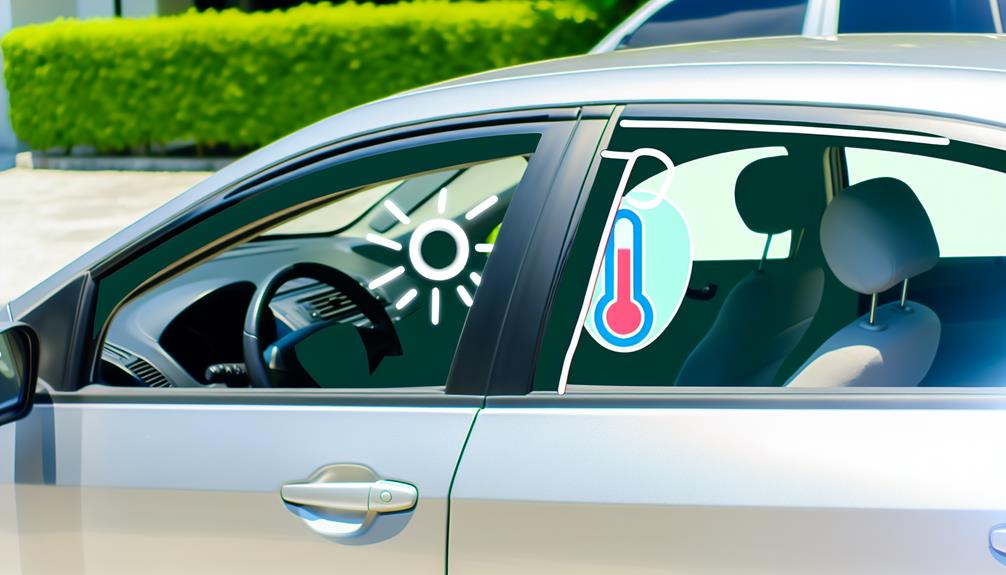In the midst of scorching summer temperatures, the issue of whether to crack car windows in hot weather remains a subject of debate among experts and concerned individuals alike.
The significance of proper ventilation within vehicles cannot be overstated, yet the potential risks associated with high temperatures inside cars are equally alarming. Factors influencing the rapid build-up of heat within a vehicle are multifaceted, prompting a closer examination of potential solutions and preventive measures.
As we explore the necessity of cracking car windows in hot weather, it becomes evident that the implications extend beyond mere comfort and convenience.
Key Takeaways
- Proper ventilation and air circulation are crucial for passenger comfort and health in hot weather.
- Strategies like window shades and cooling devices can effectively reduce interior heat without cracking windows.
- Understanding factors contributing to heat build-up helps in managing interior temperatures efficiently.
- Expert recommendations include using sunshades, servicing AC systems, and never leaving children or pets in hot vehicles.
Importance of Ventilation in Cars
Ventilation in cars plays a crucial role in maintaining a comfortable and safe environment for passengers, particularly in extreme weather conditions. Proper air circulation inside a vehicle is essential to ensure that fresh air is constantly flowing, preventing stuffiness and staleness. This circulation helps in regulating the temperature within the car, ensuring that it remains at a pleasant level for all occupants.
Temperature control is vital not only for passenger comfort but also for their health and safety. In hot weather, adequate ventilation can prevent the interior of the car from becoming unbearably hot, reducing the risk of heat-related illnesses. Additionally, in cold weather, ventilation helps to prevent the buildup of moisture inside the car, which can lead to foggy windows and compromised visibility.
Therefore, maintaining optimal ventilation through air circulation and temperature control is imperative for creating a pleasant and safe environment for everyone inside the vehicle.
Risks of High Temperatures in Vehicles
The exposure of individuals to prolonged high temperatures inside vehicles poses a significant risk to their well-being and safety. During hot weather, the interior of a car can quickly become an oven, reaching temperatures well above what is safe for humans. This can lead to heat-related illnesses, with heatstroke being a major concern.
To prevent such risks, it is crucial to take measures such as ensuring proper air conditioning is available in the vehicle. Air conditioning helps regulate the temperature inside the car, reducing the likelihood of heat-related health issues. Additionally, window tinting can provide protection from solar radiation, which can help lower the temperature inside the vehicle. Combining these strategies can significantly decrease the risks associated with high temperatures in vehicles.
It is essential for individuals to be aware of these risks and take proactive steps to safeguard their well-being when spending time in hot vehicles.
Factors Affecting Interior Heat Build-Up
Exposure to prolonged high temperatures inside vehicles can be influenced by various factors that contribute to interior heat build-up. One key factor is heat insulation, which determines how well the vehicle can retain heat. Cars with poor insulation will allow heat to penetrate easily, leading to a rapid increase in interior temperature.
Additionally, solar radiation plays a significant role in heating up the inside of a vehicle. When sunlight enters through the windows, it is absorbed by the car's interior surfaces, causing them to heat up and radiate warmth. The type of material used in the car's interior can also impact heat build-up, as certain materials are better at trapping heat than others.
Furthermore, the color of the vehicle's exterior can influence the amount of heat absorbed, with darker colors absorbing more heat compared to lighter shades. Understanding these factors is crucial in managing interior heat levels and ensuring the comfort and safety of individuals inside vehicles during hot weather.
Alternatives to Cracking Car Windows
In considering strategies to mitigate interior heat build-up in vehicles during hot weather, exploring alternative methods to cracking car windows becomes essential for maintaining a comfortable and safe environment for occupants. Instead of relying solely on cracked windows, here are some effective alternatives:
- Window Shades: Utilizing window shades can significantly reduce the amount of sunlight entering the vehicle, thereby lowering the overall temperature inside. These shades act as a barrier against direct sunlight, preventing excessive heat from accumulating.
- Ventilation: Proper ventilation is key to dissipating hot air from the car's interior. Opening doors for a brief period before entering the vehicle or using ventilation systems can help in circulating air and cooling down the cabin.
- Cooling Devices and Sun Protection: Employing cooling devices like fans or portable air conditioners can provide relief from the heat. Additionally, installing sun protection films on windows can block harmful UV rays and minimize heat transmission, creating a more comfortable environment for passengers.
Expert Recommendations for Hot Weather
Exploring further strategies beyond the use of window cracking, experts offer valuable recommendations to effectively combat the challenges posed by hot weather conditions in vehicles. To ensure a comfortable and safe driving experience during hot weather, implementing cooling strategies is paramount.
One effective method is using sunshades or visors to block direct sunlight and reduce the temperature inside the car. Additionally, investing in a reflective windshield cover can significantly lower the heat absorption by the vehicle's interior surfaces.
Regularly servicing the air conditioning system and ensuring it is in optimal condition is crucial for maintaining a cool environment within the car. Moreover, experts emphasize the importance of staying hydrated and carrying sufficient water supplies while traveling in hot weather to prevent dehydration and heat-related illnesses.
Safety precautions such as never leaving children or pets unattended in a hot vehicle and being mindful of hot surfaces like seat belts and steering wheels are essential to avoid accidents and burns. By incorporating these cooling strategies and safety measures, drivers can effectively combat the challenges of hot weather and create a more pleasant driving environment.
Frequently Asked Questions
What Are the Potential Legal Consequences of Leaving a Pet or Child in a Hot Car?
Legal implications of leaving a pet or child in a hot car include criminal charges such as neglect or endangerment. Safety protocols dictate immediate intervention in emergencies. Prevention is key; always ensure pets and children are never left unattended in a vehicle under any circumstances.
How Quickly Can Temperatures Rise in a Parked Car on a Hot Day?
In the scorching embrace of a parked car on a sunny day, temperatures can skyrocket at an alarming rate, posing a grave heatstroke risk. Window tinting may offer some relief, but cracking windows is necessary for proper ventilation.
Are There Any Specific Types of Vehicles That Are More Prone to Heat Build-Up Than Others?
Vehicle ventilation plays a crucial role in heat retention within cars. Specific types, like compact vehicles with limited airflow, are more prone to heat build-up. Ensuring adequate ventilation by cracking windows can help mitigate this issue.
Can Leaving the Air Conditioning on in a Parked Car Prevent It From Overheating?
Leaving the air conditioning on in a parked car can help prevent overheating. Utilizing solar shades to block sunlight and remote start features to cool the interior before entering can aid in maintaining a comfortable temperature.
Are There Any Innovative Technologies or Products Available to Help Regulate the Temperature Inside a Parked Car on Hot Days?
Innovative technologies like cooling mats and solar shades offer effective solutions to regulate the temperature inside parked cars on hot days. These products can help prevent overheating, protect interiors, and enhance comfort for both drivers and passengers.
Conclusion
In conclusion, it is essential to ensure proper ventilation in vehicles during hot weather to prevent the risks associated with high temperatures. Factors such as sunlight exposure and lack of airflow can contribute to interior heat build-up, making it crucial to consider alternative methods for cooling the car.
Experts recommend various strategies to maintain a comfortable temperature inside vehicles, emphasizing the importance of proactive measures to address the effects of hot weather on vehicle occupants.

